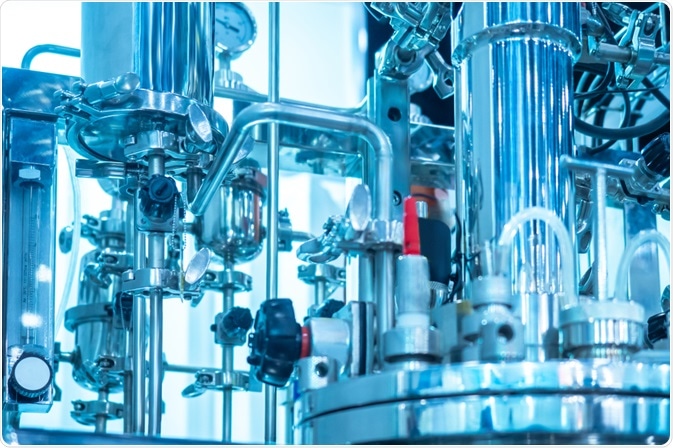Microbial bioreactors are widely used for wastewater treatment, and different reactor set-ups have been introduced to retain the microbial biomass while discharging cleaned water. The retention of microbes in the bioreactor is crucial, as the start-up time of a reactor without preformed biofilm can be several months.
 Image Credit: FOTOGRIN / Shutterstock.com
Image Credit: FOTOGRIN / Shutterstock.com
If a bioreactor cannot be run continuously, however, storage of the established biofilms would be highly beneficial for a later reactor restart. Researchers from China and Canada have recently used flow cytometry to demonstrate with fluorescent stains of dead cells that storage of the biofilm at 4 °C is best to maintain the biofilm viability.
This research has been published in the journal Water research.
Wastewater from households and various industries is rich in organic carbon and nitrogen, both important nutrients for microorganisms. However, this implies that wastewater cannot be discharged into the environment.
If high amounts of organic nutrients reach into surface waters, like rivers and lakes, they cause eutrophication that can lead to algal blooms and strong microbial growth. This can render surface waters anoxic and cloudy, conditions that are lethal for aquatic organisms such as fish and various plants.
In order to prevent such blooms, wastewater from human communities is cleaned in wastewater plants, so that only clean water is discharged to the environment. As microbes are very efficient in taking up the organic carbon and nitrogen nutrients, wastewater plants are normally bioreactors, where a controlled microbial process inside a reactor chamber consumes the nutrients, rather than an uncontrolled bloom in surface waters.
Retaining the microbes inside the reactor, therefore, becomes important, as they are required for the reactor function and shall not grow in the discharged water.
An example of such microbial bioreactors is denitrification reactors, where microbes convert nitrogen from wastewater into the gas dinitrogen (N2), which may escape into the environmental air since N2 is the air’s main component. In order to retain the microorganisms, reactor processes have been designed so that microorganisms grow in biofilms that can easily be retained by filtration.
However, since simultaneously the microbes shall be well suspended inside the wastewater, reactor types such as the moving bed bioreactor (MBBR) have been developed, where microbial biofilms are growing on solid particles that can be suspended by stirring while facilitating microbe retention during discharge of the cleaned effluent water.
Once a microbial biofilm has been grown on the MBBR particles, these particles are normally recycled, as an established MBBR-biofilm can resume water treatment immediately after a new batch of wastewater is added.
However, if the bioreactor needs to be temporarily stopped, such as for maintenance tests, a storage method for the biofilm-particles would be desirable so that reactors can be restarted faster.
A research group from China and Canada, led by Dr. Ji Li (Jiangnan University and Jiangsu College), has now demonstrated that a 4 °C storage is optimal for denitrification biofilms and demonstrated by flow cytometry that it minimizes the death of cells inside the biofilm.
Keeping microbial biofilms alive
The investigators received MBBR particles with denitrifying biofilms from a wastewater treatment plant. Samples were stored at 4°C, 20 °C or -20 °C for five months, after which biofilms where disintegrated. The individualized cells were fluorescently stained with a commercial stain for dead cells and counted by flow cytometry.
Additionally, the scientists used the stored biofilms to start up laboratory-scale bioreactors to correlate their flow cytometry findings with actual denitrification activity in the reactor.
The scientists demonstrated that the survival of cells was highest in the biofilms stored at 4 °C. The higher survival correlated with a higher denitrification rate after restarting a reactor with the biofilms. As it is conceivable that microbial biofilms survive better at lower, but not freezing, temperatures, this flow cytometry method can become useful to monitor stored biofilms for industrial bioreactors.
Starting up a bioreactor can be expensive; an easy method to assess the biofilm viability in advance can lower the likelihood of failing or delaying reactor start-ups.
Source
Wang S et al. Reactivation and pilot-scale application of long-term storage denitrification biofilm based on flow cytometry. Water Research 2019, 148, 368-377; DOI: 10.1016/j.watres.2018.10.072.
Further Reading
- All Flow Cytometry Content
- Flow Cytometry Methodology, Uses, and Data Analysis
- Flow Cytometry Techniques used in Medicine and Research
- Flow Cytometry History
- Fluorescence-Activated Cell Sorting
Last Updated: Nov 13, 2019

Written by
Christian Zerfaß, Ph.D.
Christian is an enthusiastic life scientist who wants to understand the world around us. He was awarded a Ph.D. in Protein Biochemistry from Johannes Gutenberg University in Mainz, Germany, in 2015, after which he moved to Warwick University in the UK to become a post-doctoral researcher in Synthetic Biology.
Source: Read Full Article
